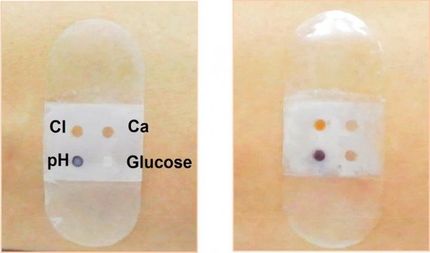Sweat for health: Sensor Patches as Fitness Trackers
The electronic patch generates highly precise data, sent directly and in real time to a coupled smartphone
The Eurostars project XPatch is developing a flexible sensor system that can track biochemical information in real time. The international consortium is working on a new generation of diagnostic patches that monitor the sweat of high performance athletes for second-by-second medical information about their cardiovascular fitness. As part of the project, Fraunhofer IZM is working on the energy supply, communication, and system integration concepts for the flexible and autonomous fitness monitor.

Professional athletes benefit immensely from detailed information about their physical state. The extremely sensitive electronic XPatch generates highly precise data from the wearer’s sweat, sent directly and in real time to a coupled smartphone.
© Fraunhofer IZM | Volker Mai
Staying active means staying healthy – and not just in times of quarantines and lockdowns. More and more physically active people want to know what their athletic efforts are doing for their bodies and which exercises might be beneficial or even detrimental for them. The international scientific XPatch project has brought together biosensoric experts to design a patch with specialized microelectronics for the fitness and medical technology market that can capture and visualize exactly this data on mobile devices.
How could a patch supercharged with advanced electronics work as a fitness tracker? The tiny health monitor includes antenna and integrated circuits for wireless communication with a Bluetooth device, a flexible micro-battery for autonomous operation, the necessary analogue circuit, and the power management components. The microelectronics specialists at the Fraunhofer Institute for Reliability and Microintegration IZM have developed the packaging and integration technology needed to fit all of the miniscule biosensors and electronics into a flexible patch that is suitable for use in active athletics. All told, the patch and its components are designed to be less than a millimetre thick.
XPatch is a biocompatible and flexible module, worn directly on the skin. This called for a soft and stretchable skin-like choice of material, like polyurethane and silicon. As the electronics are embedded in that material, the components are fully protected and never in direct contact with bare skin. The patch’s thin biochemical sensor chips are where the magic happens: They are placed into the surface of the patch, where they are kept close to the skin. A tiny opening in the substrate allows the sweat analysis to work. A miniscule piece of fabric is integrated in the empty space behind the chip and captures the wearer’s perspiration. The sensor built into the chip analyses this sample and pushes the resulting data in real time to a device, where the user can visualize the information and use the insights to improve their physical fitness.
This can be used to analyse the sweat of athletes and display the resulting data immediately and in real time on mobile devices. In order to get the captured biochemical data to a smartphone coupled with the patch, Fraunhofer IZM integrated a special wireless interface into the flexible patch that uses the particularly efficient Bluetooth Low Energy protocol. The antenna needed to achieve this had to be particularly compact, but also robust enough to cope with the unique requirements of the application’s pliable material and special electrical properties.
After the ultra-sensitive patch passed its technical validation, work started on fully functional prototypes that will soon grace the bodies of athletes for initial trials in late August. The XPatch project has received support as part of the EUROSTARS programme of the German Ministry of Education and Research and will continue its work until the end of 2020, with the continued contribution of project partners from four countries: Xsensio from Switzerland contributing the lab-on-chip sweat analytics, R-DAS from Slovakia handling the ASIC and analogue circuit design, and the VU Amsterdam conducting physiological tests and, together with OLT from Germany, managing the data analytics.
Fraunhofer IZM is particularly interested in the new insights concerning flexible substrates or the integration of electronic components, like batteries and antennas, in medical applications. These innovations have the potential to be employed by medical technology firms and component or material makers, working to introduce novel products or optimize existing technologies. The ambition is to launch new products based on the XPatch project’s findings already within the next five years.


























































